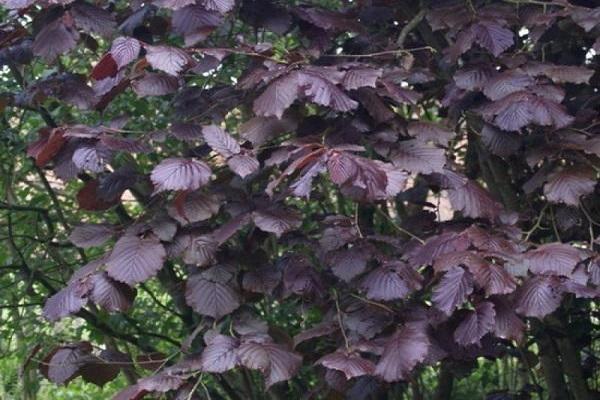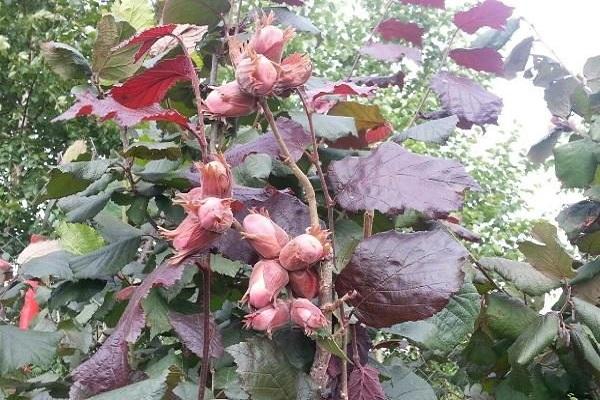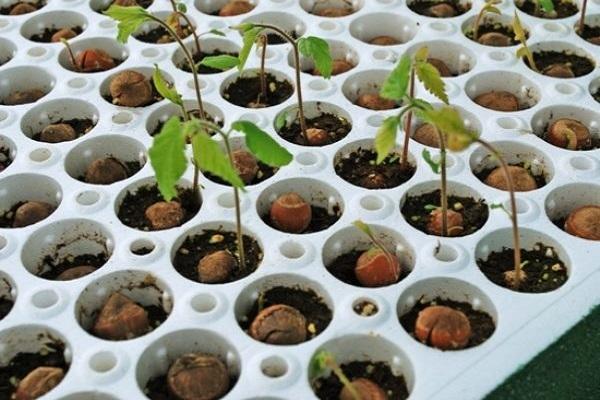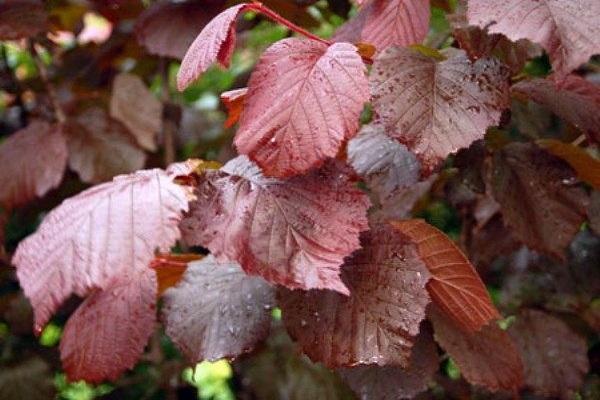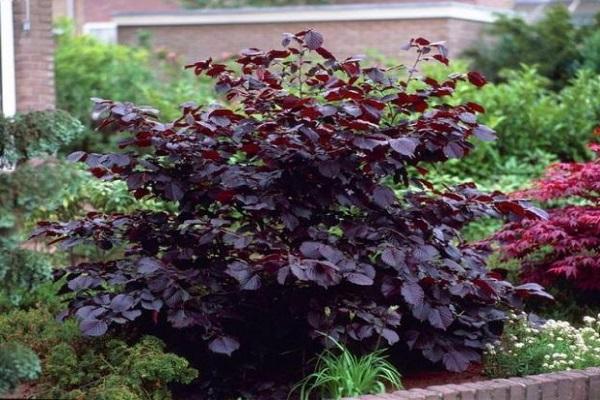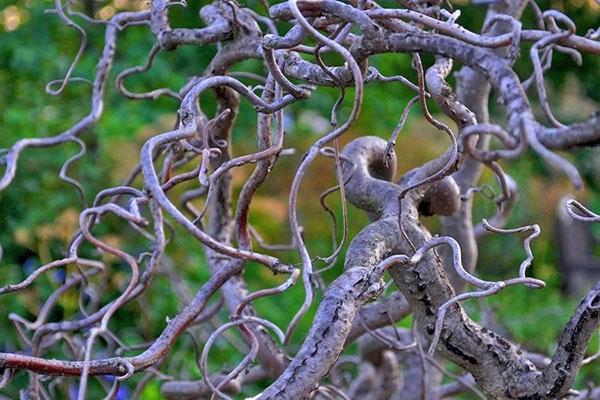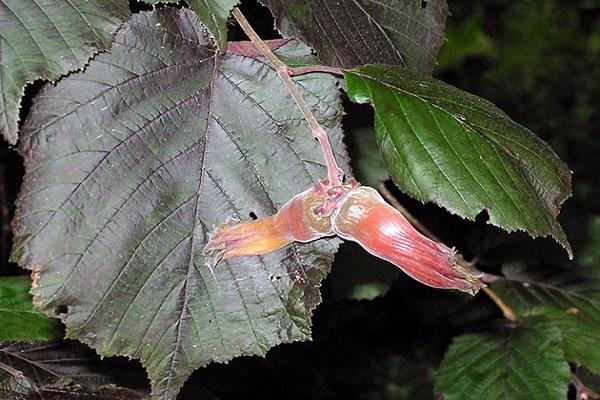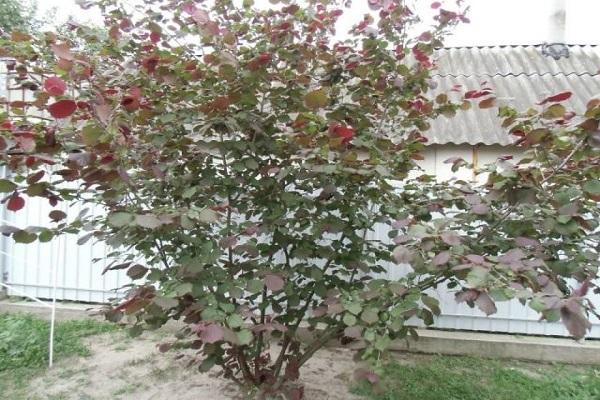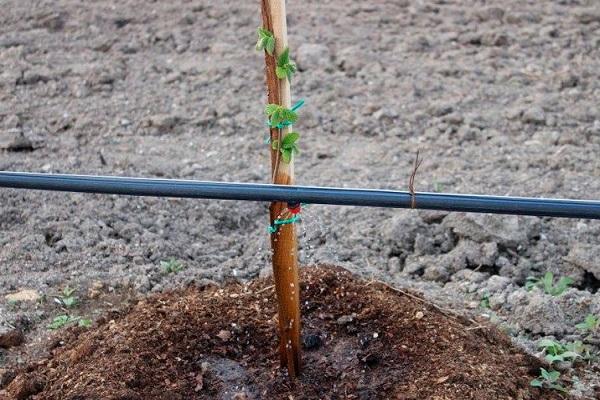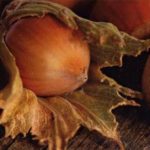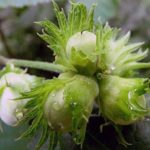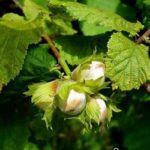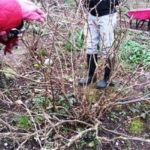Red-leaved hazel bushes are known for the benefits of their fruits and decorative characteristics. Wild plants fit harmoniously into any landscape and, if properly cared for, produce nuts with high taste.
- General information about the plant
- Main positive and negative aspects
- Growing Red Leaf Hazel
- When to plant
- Selection of planting material
- Planting process
- Subtleties of crop care
- Watering
- Top dressing
- Caring for hazel during flowering
- Wintering
- Trimming
- Plant pests and diseases
- Hazel pests
- Kidney mite
- Nut weevil
- Walnut (hazelnut) barbel
- Walnut leaf beetle
- Hazel diseases
- Powdery mildew
- Rust
- White rot
- Hazel propagation
- Hazel processing
- By layering
- Seeds
- Dividing the bush
- By cuttings
- Decorative properties of hazel
- Harvesting
General information about the plant
Red-leaved hazelnuts are spreading bushes with large branches and dense foliage. Gardeners often plant hazel trees as hedges. The plant belongs to the bisexual category; inflorescences are formed in early spring before foliage grows. During the development process, the inflorescences produce fruit ovaries, which acquire a dark brown hue in late summer - early autumn. Nut shell color is the main indicator of ripeness.
Main positive and negative aspects
Growing hazelnuts has a number of benefits. Gardeners highlight the following positive aspects:
- Due to the spherical shape and red color of the foliage, the plants are used as a decorative element in the landscape design of the site.
- Hazel fruits have nutritional and beneficial properties. Nuts contain large amounts of protein and other microelements.
- Hazel plants are easy to care for and resistant to strong temperature changes.
The main disadvantage of garden crops is the poor development of roots during propagation. If the soil fertility is insufficient or environmental conditions are unfavorable, hazel tree propagation can be difficult.
Growing Red Leaf Hazel
Planting a hazel tree on a summer cottage requires an integrated approach. In order for the plants to take root well and continue active development, it is necessary to first prepare the planting material, observe the timing and planting technologies.
When to plant
Shrubs can be planted in open soil in the spring, before the sap begins to flow, or in the fall.In the case of autumn planting of hazel, the plants should be planted 3-4 weeks before the first frost, so that they have time to take root and adapt to new conditions.
Selection of planting material
For cultivation, it is recommended to select several hazelnut seedlings that differ in their ripening period. This way the plants will pollinate each other well. Hazel seedlings should have a small number of leaf blades and a developed rhizome. Suitable root length is at least 30 cm.
When choosing a hazel seedling, it is important to make sure that more than 3 shoots have formed on it. It is also necessary to inspect the plants and make sure there is no damage or signs of rotting.
Before planting, hazel seedlings are trimmed to 30-35 cm. The roots of the plants are soaked in a growth stimulator. Preparing a place for placing seedlings on the site involves digging a hole measuring 60 x 60 cm and applying fertilizing. To saturate hazel seedlings with nutritional components, a mixture of the following substances is suitable:
- humus;
- superphosphate;
- potassium salt.
Planting process
A mound of earth is poured in the central part of the planting holes for the purpose of rooting hazel seedlings. The roots soaked in the growth stimulator are straightened to the sides and carefully placed in the hole. The shoots are fixed in a vertical position, tied to pegs that are secured inside the hole. Then the roots are sprinkled with loosened soil and the top layer is slightly compacted. The root collar of the hazel is placed 5 cm above the ground.
Subtleties of crop care
All hazel varieties, including common hazel Purpurea, require regular care. Despite the unpretentiousness of the plants, the development of shrubs, the abundance of fruiting and the taste characteristics of hazelnuts depend on proper care.
Watering
Redleaf hazel likes moist soil, but too much water can cause root destruction. Immediately after planting, the hazel bushes are watered with 2-3 buckets of water, after which the tree trunk area is covered with a layer of mulch from pine branches or sawdust.
After a week, repeat watering. It is important to ensure that the water from the previous irrigation is completely absorbed into the soil. Avoid stagnation of liquid near hazel shoots and excessive moisture in the lower layers of the soil.
In summer, it is enough to water 2-3 times a month. The average liquid consumption per hazel bush is 10 liters. When active fruit formation occurs, the roots must always be in a moderately moist state.
Top dressing
It is recommended to apply organic fertilizers to the soil once every 3-4 years. Compost and humus are used for this purpose. Complex mineral fertilizers are used annually. In anticipation of fruiting, the soil is fertilized with a urea solution, and at the beginning of summer it is treated with nitrogen fertilizers.
Caring for hazel during flowering
An important stage of care at the moment of flowering of hazel is loosening the soil. The procedure should be performed after each watering so that a sufficient amount of oxygen penetrates to the roots located in the lower layers of the earth. Also during the formation of inflorescences, preventive treatments of plants against diseases and insects will have a beneficial effect.
Wintering
Young hazel seedlings up to 4 years old must be protected from frost for the entire winter period using agrofibre, plastic film or other dense material. Tall hazel shoots can be bent to the ground and fixed with rods or metal brackets, and covered with spruce branches on top.
Shrubs older than 4 years, as well as varieties with increased winter hardiness, tolerate frost well without shelter.
Trimming
Red-leaved hazel is pruned in late autumn, after the leaves have fallen. During the formation process, damaged branches are removed and thickened areas are thinned out. Shrubs form starting from the center of the crown. Thanks to pruning, the sun's rays penetrate to undeveloped shoots, which has a positive effect on fruiting.
Plant pests and diseases
Unfavorable environmental conditions or improper care lead to disease and insect damage. To protect the hazel tree, protective sprays are required.
Hazel pests
Insects that pose a danger to hazel have characteristic external signs. In order to take the right measures, it is necessary to promptly determine the type of pest by reading the description.
Kidney mite
Due to its small size, it is almost impossible to notice the bud mite on hazel. Damage to a hazel tree by this pest is characterized by swelling and enlargement of the buds, which are unable to form shoots and leaves.
Nut weevil
Weevils are brown bugs with an oblong proboscis. Female insects lay eggs in unripe fruits. The hatched caterpillars feed on the pulp of the nuts.
Walnut (hazelnut) barbel
The hazelnut beetle is able to penetrate the core of the bush and eat it from the inside. The peculiarity of the pest complicates the process of combating it.
Walnut leaf beetle
This pest settles on hazel foliage and gradually gnaws through it. Due to a leaf beetle invasion, you can lose up to half of your harvest.
Hazel diseases
Among many diseases, hazel most often suffers from fungal infections.Pathogenic microorganisms are especially active in wet and cool weather.
Powdery mildew
A pronounced sign of the disease is a white coating on the foliage. Without control, the leaves turn black and die over time.
Rust
Rust infection causes dark spots to form on the leaves. The disease provokes drying of the foliage and a reduction in yield.
White rot
The disease spreads from the leaves to the fruits and stem. To protect the hazel tree, infected parts must be destroyed.
Hazel propagation
The procedure for propagating shrubs allows you to increase their number on the site. Reproduction can be done in several ways.
Hazel processing
When planning the propagation of shrubs, treatment should be carried out. Plantings are sprayed with a disinfecting solution, as well as drugs against pests and diseases for preventive purposes.
By layering
For propagation by layering, young shoots of purple hazel are used. The cuttings are inclined towards the soil and placed in a ditch built next to the mother bush. The end of the shoot is fixed and covered with earth so that it forms its own shoots.
Seeds
Using seed material is the longest and most labor-intensive option. For planting, the strongest nuts are selected and germinated in a separate container. Grown seedlings are transferred to the ground and cared for according to the basic scheme.
Dividing the bush
To divide shrubs, you need to dig up a young, mature plant and divide it into several trunks up to 30 cm long with roots. The trunks are planted in separate holes and rooted.
By cuttings
Taking healthy and strong cuttings from two-year-old shrubs, you need to place them in containers with a mixture of peat and sand.Thanks to constant watering of the soil, the shoots will begin to take root.
Decorative properties of hazel
Due to the bright color of the foliage, Purpurea hazel is often used to decorate summer cottages. Hazel trees look harmonious in the landscape when placed separately or when creating a hedge.
Harvesting
Red-leaved hazelnuts begin to bear fruit after 4 years of development. The nuts do not ripen until late summer. Ripe specimens darken noticeably and slightly separate from the branches. It is recommended to dry the collected fruits in the open air and store them in canvas bags.

